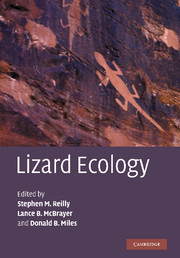Book contents
- Frontmatter
- Contents
- List of contributors
- Preface
- Historical introduction: on widely foraging for Kalahari lizards
- I Organismal patterns of variation with foraging mode
- 1 Movement patterns in lizards: measurement, modality, and behavioral correlates
- 2 Morphology, performance, and foraging mode
- 3 Physiological correlates of lizard foraging mode
- 4 Lizard energetics and the sit-and-wait vs. wide-foraging paradigm
- 5 Feeding ecology in the natural world
- 6 Why is intraspecific niche partitioning more common in snakes than in lizards?
- 7 Herbivory and foraging mode in lizards
- 8 Lizard chemical senses, chemosensory behavior, and foraging mode
- 9 Patterns of head shape variation in lizards: morphological correlates of foraging mode
- 10 Prey capture and prey processing behavior and the evolution of lingual and sensory characteristics: divergences and convergences in lizard feeding biology
- 11 The meaning and consequences of foraging mode in snakes
- II Environmental influences on foraging mode
- Index
- References
6 - Why is intraspecific niche partitioning more common in snakes than in lizards?
Published online by Cambridge University Press: 04 August 2010
- Frontmatter
- Contents
- List of contributors
- Preface
- Historical introduction: on widely foraging for Kalahari lizards
- I Organismal patterns of variation with foraging mode
- 1 Movement patterns in lizards: measurement, modality, and behavioral correlates
- 2 Morphology, performance, and foraging mode
- 3 Physiological correlates of lizard foraging mode
- 4 Lizard energetics and the sit-and-wait vs. wide-foraging paradigm
- 5 Feeding ecology in the natural world
- 6 Why is intraspecific niche partitioning more common in snakes than in lizards?
- 7 Herbivory and foraging mode in lizards
- 8 Lizard chemical senses, chemosensory behavior, and foraging mode
- 9 Patterns of head shape variation in lizards: morphological correlates of foraging mode
- 10 Prey capture and prey processing behavior and the evolution of lingual and sensory characteristics: divergences and convergences in lizard feeding biology
- 11 The meaning and consequences of foraging mode in snakes
- II Environmental influences on foraging mode
- Index
- References
Summary
Introduction
The scientific literature on foraging biology in lizards has tended to ignore intraspecific variation. Thus, the species is treated as the unit of analysis, under the implicit assumption that variation within a single species (and, to an even greater degree, within a single population) is trivial relative to variation among species. Many authors therefore talk of broad phylogenetic patterns in foraging mode, with all taxa within major lineages placed within the same major category (e.g. active or ambush). Such generalizations may have substantial value in pursuing broad issues, but at the population level they are simply wrong for many types of organism.
Groups of related species certainly share many distinctive features of foraging biology, and there is a genuine validity to statements about lineage-wide patterns. None the less, a detailed analysis of almost any single population (let alone one species) is likely to reveal diversity in trophic biology. For example, juveniles may feed in different ways, in different places and on different kinds and sizes of prey than do adults within the same population. Similarly, males and females may differ in prey utilization. For several reasons, snakes offer more dramatic examples of such intraspecific niche divergence than do lizards. In this chapter, we review published evidence for size and sex effects on foraging biology in snakes, consider underlying biological factors that generate such diversity, and attempt to explain why snakes and lizards – two very closely related groups of organisms – differ so dramatically in the occurrence of intraspecific niche partitioning.
- Type
- Chapter
- Information
- Lizard Ecology , pp. 173 - 208Publisher: Cambridge University PressPrint publication year: 2007
References
- 26
- Cited by



